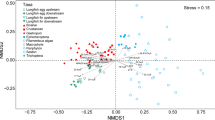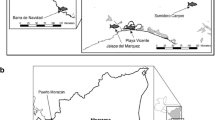Abstract
The summer flounder Paralichthys dentatus and winter flounder Pseudopleuronectes americanus support valuable fisheries along the northeastern United States. The importance of these flatfish as a human dietary resource indicates they are potential sources of mercury (Hg) to fish-consuming citizens. In this study, summer flounder (SF) and winter flounder (WF) were collected from the Narragansett Bay (Rhode Island, USA) and were measured for total Hg burden in whole-body or dorsal muscle tissue. Interspecies differences in Hg contamination were analyzed relative to flounder body size, age, and Hg content of preferred prey. Stable isotope signatures were also used to elucidate the effect of trophic processes on Hg accumulation in the estuarine food web. The mean Hg content of SF exceeded concentrations measured in WF across multiple life-history stages (0.039–0.100 and 0.016–0.029 mg Hg/kg wet weight for SF and WF, respectively), and observed values for both species were lower than the US Environmental Protection Agency regulatory threshold of 0.3 mg Hg/kg wet weight. Total Hg concentrations were also positively correlated with flounder age and length, verifying that both flatfish bioaccumulate Hg. SF accumulate Hg at an accelerated rate, however, owing to this species consuming Hg-enriched prey (teleosts, squid, and macrocrustaceans; mean Hg content = 0.023 mg Hg/kg wet weight), whereas WF feed on prey with low Hg levels (amphipods and polychaetes; mean Hg content = 0.013 mg Hg/kg wet weight). The positive correlation observed between mean biota Hg content and stable nitrogen (δ15N) isotope signatures further indicates that Hg is trophically transferred through the food web, and higher trophic level organisms (i.e., enriched δ15N) have increased Hg concentrations. Therefore, results from this study suggest that dietary preference and trophic structure are the main factors affecting Hg bioaccumulation in the estuary. Total Hg concentrations of flatfish from the Narragansett Bay, however, do not necessarily reflect coastwide contamination patterns. This reinforces the importance of having research conducted at sufficiently small spatial scales, including the local assessment of Hg contamination for the purpose of issuing state consumption advisories.






Similar content being viewed by others
References
Adams DH, McMichael RH Jr (2007) Mercury in king mackerel, Scomberomorus cavalla, and Spanish mackerel, S. maculatus, from waters of the south-eastern USA: Regional and historical trends. Marine Freshwater Res. 58:187–193
Adams DH, Onorato GV (2005) Mercury concentrations in red drum, Sciaenops ocellatus, from estuarine and offshore waters of Florida. Marine Pollut Bull 50:291–300
Anderson PD, Wiener JB (1995) Eating fish. In: Graham JD, Wiener JB (eds) Risk versus risk: Tradeoffs in protecting health and the environment. Harvard University Press, Cambridge, MA, pp 104–123
Bank MS, Chesney E, Shine JP, Maage A, Seen DB (2007) Mercury bioaccumulation and trophic transfer in sympatric snapper species from the Gulf of Mexico. Ecol Appl 17:2100–2110
Bloom NS (1992) On the chemical form of mercury in edible fish and marine invertebrate tissue. Can J Fish Aquat Soc 49:1010–1017
Bowman RE, Stillwell CE, Michaels WL, Grosslein MD (2000) Food of Northwest Atlantic fishes and two common species of squid. NOAA Tech. Memo. NMFS-F/NE-155
Branco V, Vale C, Canário J, Santos MN (2007) Mercury and selenium in blue shark (Prionace glauca, L. 1758) and swordfish (Xiphias gladius, L. 1758) from two areas of the Atlantic Ocean. Environ Pollut 150:373–380
Cai Y, Rooker JR, Gill GA, Turner JP (2007) Bioaccumulation of mercury in pelagic fishes from northern Gulf of Mexico. Can J Fish Aquat Sci 64:458–469
Cizdziel JV, Hinners TA, Pollard JE, Heithmar EM, Cross CL (2002) Mercury concentrations in fish from Lake Mead, USA, related to fish size, condition, trophic level, location, and consumption risk. Arch Environ Contam Toxicol 43:309–317
Collette BB, Klein-MacPhee G (eds) (2002) Bigelow and Schroeder’s fishes of the Gulf of Maine, 3rd edn. Smithsonian Institution Press, Washington, DC
Collie JS, Wood AD, Jeffries HP (2008) Long-term shifts in the species composition of a coastal fish community. Can J Fish Aquat Sci 65:1352–1365
Daviglus M, Sheeshka J, Murkin E (2002) Health benefits from eating fish. Comments Toxicol 8:345–374
FDA (Food and Drug Administration) (2004) Mercury levels in commercial fish and shellfish. Food and Drug Administration, Washington, DC. http://vm.cfsan.fda.gov/~frf/sea-mehg.html
France RL (1995) Carbon-13 enrichment in benthic compared to planktonic algae: food web implications. Marine Ecol Prog Ser 124:307–312
Fry B, Sherr EB (1984) δ13C measurements as indicators of carbon flow in marine and freshwater ecosystems. Contrib Marine Sci 27:13–47
Grandjean P, Weihe P, White R, Debes F, Arak S, Yokoyama K, Murata K, Sorensen N, Dahl R, Jorgensen P (1997) Cognitive deficit in 7-year-old children with prenatal exposure to methylmercury. Neurotoxicol Teratol 20:1–12
Gray JS (2002) Biomagnification in marine systems: the perspective of an ecologist. Marine Pollut Bull 45:46–52
Greig RA, Wenzloff DR (1977) Trace metals in finfish from the New York Bight and Long Island Sound. Marine Pollut Bull 8:198–200
Grieb TM, Driscoll C, Gloss S, Schofield C, Bowie G, Porcella D (1990) Factors affecting mercury accumulation in fish in the Upper Michigan Peninsula. Environ. Toxicol Chem 9:919–930
Grosslein MD, Azarovitz TR (1982) Fish distribution. MESA New York Bight Atlas Monograph No. 15. New York Sea Grant Institute, Albany, NY
Hall BD, Bodaly RA, Fudge RJ, Rudd JW, Rosenberg DM (1997) Food as the dominant pathway of methylmercury uptake by fish. Water Air Soil Pollut 100:13–24
Hammerschmidt CR, Fitzgerald WF (2006) Bioaccumulation and trophic transfer of methylmercury in Long Island Sound. Arch Environ Contam Toxicol 51:416–424
Harvey J, Harwell L, Summers JK (2008) Contaminant concentrations in whole-body fish and shellfish from US estuaries. Environ Monit Assess 137:403–412
Lake JL, Ryba SA, Serbst J, Brown CF, IV Gibson L (2007) Mercury and stable isotopes of carbon and nitrogen in mink. Environ Toxicol Chem 26:2611–2619
Lynch T (2000) Assessment of recreationally important finfish stocks in Rhode Island waters. Coastal Fishery Resource Assessment Trawl Survey. RIDEM, Division of Fish and Wildlife. Government Center, Wakefield, RI
Michener RH, Schell DM (1994) Stable isotope ratios as tracers in marine and aquatic food webs. In: Lajtha K, Michener RH (eds) Stable isotopes in ecology and environmental science. Blackwell Scientific, Oxford, pp 138–157
Moszczynski P, Lisiewicz J, Bartus R, et al (1990) The serum immunoglobulins in workers after prolonged occupational exposure to the mercury vapors. Rev Roum Med Intern 28:25–30
National Marine Fisheries Service, Fisheries Statistics Division (2009) http://www.st.nmfs.noaa.gov/st1/. Accessed 8 Oct 2009
Newell RIE (1989) Species profiles: life histories and environmental requirements of coastal fishes and invertebrates (North and Mid-Atlantic). Blue mussel. U.S. Fish. Wildl. Serv. Biol. Rep. 82(11.102). U.S. Army Corps of Engineers, TR El-82-4. 25 pp
Olla BL, Samet CE, Studholme AL (1972) Activity and feeding behavior of the summer flounder (Paralichthys dentatus) under controlled laboratory conditions. Fish Bull 70:1127–1136
Packer DB, Griesbach SJ, Berrien PL, Zetlin CA, Johnson DL, Morse WW (1999) Essential fish habitat source document: Summer flounder, Paralichthys dentatus, life history and habitat characteristics. National Oceanic and Atmospheric Administration (NOAA) Technical Memorandum, NOAA/National Marine Fisheries Service-NE-151
Patterson J (2002) Introduction—comparative dietary risk: balance the risks and benefits of fish consumption. Comments Toxicol 8:337–344
Pearcy WG (1962) Ecology of an estuarine population of winter flounder, Pseudopleuronectes americanus (Walbaum), Parts I–IV. Bull Bingham Oceanogr Coll 18:1–78
Penttila J, Dery LM (eds) (1988) Age determination methods for Northwest Atlantic species. National Oceanic and Atmospheric Administration (NOAA) Technical Report, NOAA, National Marine Fisheries Service 72
Pereira J, Goldberg R, Ziskowski JJ, Berrien PL, Morse WW, Johnson DL (1999) Essential fish habitat source document: Winter flounder, Pseudopleuronectes americanus, life history and habitat characteristics. National Oceanic and Atmospheric Administration (NOAA) Technical Memorandum, NOAA/National Marine Fisheries Service-NE-138
Peterson BJ, Fry RW (1987) Stable isotopes in ecosystem studies. Ann Rev Ecol Syst 18:293–320
Peterson SA, Van Sickle J, Hughes RM, Schacher JA, Echols SF (2005) A biopsy procedure for determining filet and predicting whole-fish mercury concentration. Arch Environ Contam Toxicol 48:99–107
Piraino MN, Taylor DL (2009) Bioaccumulation and trophic transfer of mercury in striped bass (Morone saxatilis) and tautog (Tautoga onitis) from the Narragansett Bay (Rhode Island, USA). Marine Environ Res 67:117–128
Post DM (2002) Using stable isotopes to estimate trophic positions: models, methods, and assumptions. Ecology 83:703–718
Pruell RJ, Taplin BK, Lake JL, Jayaraman S (2006) Nitrogen isotope ratios in estuarine biota collected along a nutrient gradient in Narragansett Bay, Rhode Island, USA. Marine Pollut Bull 52:612–620
RIDEM (Rhode Island Department of Environmental Management) (2008) Rhode Island marine fisheries statutes and regulations, Part VII—minimum sizes of fish/shellfish. Rhode Island Department of Environmental Management, Bureau of Natural Resources, Fish and Wildlife and Law Enforcement
Salonen JT, Seppänen K, Nyyssçnen K, Korpela H, Kauhanen J, Kantola M, Tuomilehto J, Esterbauer H, Tatzber F, Salonen R (1995) Intake of mercury from fish, lipid peroxidation, and the risk of myocardial infarction and coronary, cardiovascular, and any death in eastern Finnish men. Circulation 91:645–655
Sorensen N, Murata K, Budtz-Jorgensen E, Weihe P, Grandjean P (1999) Prenatal methylmercury exposure as a cardiovascular risk factor at seven years of age. Epidemiology 10:370–375
Sutherland EM (2007) Mercury exposure from domestic and imported estuarine and marine fish in the U.S. seafood market. Environ Health Perspect 115:235–242
Trudel M, Rasmussen JB (2006) Bioenergetics and mercury dynamics in fish: a modeling perspective. Can J Fish Aquat Sci 63:1890–1902
US EPA (US Environmental Protection Agency) (1997) Mercury study report to congress. Fate and transport of mercury in the environment, Vos. I–VII, EPA-452/R-97-005. US Environmental Protection Agency, Washington, DC
US EPA (US Environmental Protection Agency) (1998) Mercury in solids and solutions by thermal decomposition, amalgamation, and atomic absorption spectrophotometry. EPA Method 7473 Report. US Environmental Protection Agency, Washington, DC
US EPA (US Environmental Protection Agency) (2003) Mercury in marine life. US. Environmental Protection Agency, Office of Wetlands, Watersheds, and Oceans, Oceans and Coastal Protection Division, Washington, DC
US EPA (US Environmental Protection Agency) (2006) Draft guidance for implementing the January 2001 methylmercury water quality criterion. EPA 823-B-04-001. US Environmental Protection Agency, Office of Water, Washington, DC
US EPA (US Environmental Protection Agency) (2009) U.S. EPA Environmental Monitoring and Assessment Program National Coastal Assessment, Northeast Region 2000–2002. http://www.epa.gov/emap/nca/. Accessed 16 June 2009)
Wang JS, Lee T-C, Wolke RE, Saila SB (1996) PCB and heavy metal residues in livers and muscles of winter flounder (Pseudopleuronectes americanus) from Rhode Island waters. Toxicol Environ Chem 55:19–30
Wiener JG, Krabbenhoft DP, Heinz GH, Scheuhammer AM (2003) Ecotoxicology of mercury. In: Hoffman DJ, Rattner BA, Burton GA Jr, Cairns J Jr (eds) Handbook of ecotoxicology. Lewis Publishers, Boca Raton, pp 409–463
Woolcott WS, Beirne C, Hall WM Jr (1968) Descriptive and comparative osteology of the young of three species of flounder, genus Paralichthys. Chesapeake Sci 9:109–120
Acknowledgments
We are grateful to J. C. Powell and S. Olszewski (Rhode Island Division of Fish and Wildlife, Jamestown, RI), K. Henry (University of Rhode Island/Graduate School of Oceanography, Narragansett, RI), and J. Szczebak, M. Piraino, J. Linehan, S. Helming, L.F. Ho, M. Gardner, and B. Bourque (Roger Williams University, Bristol, RI) for assistance in sample collection and preparation. We thank R. Michener (Boston University Stable Isotope Laboratory, Boston, MA) and B. Jackson (Dartmouth College, Trace Metals Laboratory, Hanover, NH) for stable isotope and methylmercury analyses, respectively. We also thank D. Nacci (US Environmental Protection Agency, Atlantic Ecology Division, Narragansett, RI) and M. Bank (Harvard School of Public Health, Department of Environmental Health, Boston, MA) for suggestions on experimental design. Some of the data described in this manuscript were produced by the US Environmental Protection Agency through its Environmental Monitoring and Assessment Program (EMPA). The project described was supported by the Roger Williams University Foundation Fund Based Research Grant and by Award Number P20RR016457 from the National Center for Research Resources. The content is solely the responsibility of the authors and does not necessarily represent the official views of the National Center for Research Resources or the National Institutes of Health.
Author information
Authors and Affiliations
Corresponding author
Rights and permissions
About this article
Cite this article
Payne, E.J., Taylor, D.L. Effects of Diet Composition and Trophic Structure on Mercury Bioaccumulation in Temperate Flatfishes. Arch Environ Contam Toxicol 58, 431–443 (2010). https://doi.org/10.1007/s00244-009-9423-7
Received:
Accepted:
Published:
Issue Date:
DOI: https://doi.org/10.1007/s00244-009-9423-7




